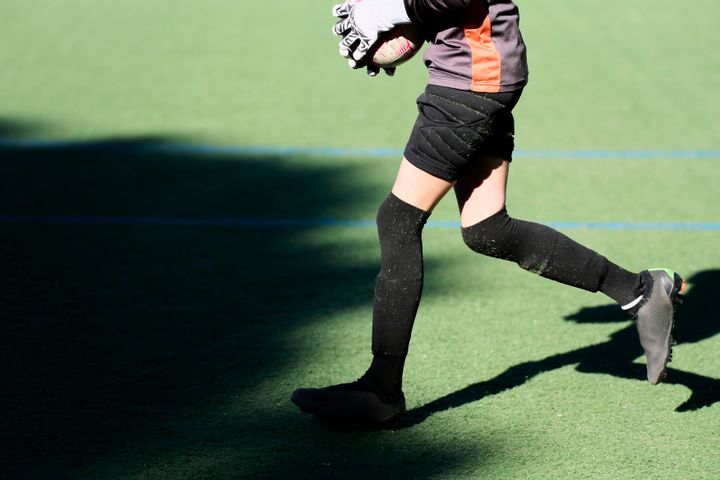
When Miles Pitcher was 13 years old, he came out to his friends as trans. A year later, he came out to his family too.
Like many young people, sport has played a huge role in his formative years. But being trans, he has faced a greater number of challenges in this area than most.
He’s not alone, new research has found 52% of trans and non-binary young people feel their gender identity has impacted them taking part in sport.
While sadly a third worry about taking part in sport because of negative media stories about trans people.
“I attend a single-sex female school, and though they were really supportive when I came out as trans, there were some hurdles,” Pitcher tells HuffPost UK.
One issue was that he felt uncomfortable wearing skorts (a skirt and shorts combined), which were part of the compulsory PE kit.
He advocated for the reintroduction of shorts, a gender-neutral option, so people would have the option to choose between the two – something the school accepted.
Despite drives for inclusivity, there are still a number of barriers trans and non-binary pupils face when it comes to accessing and enjoying sport and physical education (or PE) at school, as highlighted in a new report by the charity Mermaids.
Such barriers include gendered clothing, single-sex changing rooms and teams split into boys and girls which can exclude those who are non-binary or can trigger gender dysphoria – the distress a person experiences due to a mismatch between their gender identity and their sex assigned at birth.
Pitcher loves rugby, but strict gendered teams meant he would have to line up with the girls’ team “for fear of judgement and harassment” – an experience that he says made him feel dysphoric.
Yet when they played tournaments overseas, which allow for mixed gender teams, he was able to share the pitch with players he identified with – a huge moment of relief.
“I believe someone should be judged by their ability not their gender,” he says. “We need more gender-neutral options where possible and for our concerns to be seen as valid too.”
Sport and exercise are hugely important to our health and wellbeing, but school can be a minefield to navigate for teens because of rules and regulations. Strict PE uniform policies, for instance, impact lots of teens – not just those who are trans or non-binary.
Recent research by Women In Sport found some items of PE kit can make adolescent girls feel uncomfortable – 60% of girls aged 15-18-years-old disliked wearing shorts or skorts and 63% said they felt self-conscious in the required clothing.
They also anecdotally reported that gendered school PE kits made them feel sexualised.
Lots of trans and non-binary teens want to take part in sport – in fact, Pitcher, now 17, has competed in athletics, football, MMA and now rugby – simply because they love it and are good at it.
Over a third of trans youth take part in sport two to three times a week, with the biggest motivations being to have fun, see friends and get fit and healthy.
But sadly the barriers these kids experience are not always realised by some teachers and coaches.
Sam Quaint came out as queer at 16 and identifies as non-binary. From a really young age they competed at a high level in sport, something they loved to do.
Since lockdown however, Quaint says they haven’t competed in sport as binary competition categories, uniforms and changing areas force them to misgender themselves to be included.
When Mermaids asked 180 trans and non-binary young people about their experiences, the responses were eye-opening and showed Quaint’s experience is far from unique.
One person said: “I hate when at school we are split by gender because I am out at school and to my peers, but am still pressured to stay with my assigned gender at birth. I feel accepted until it comes to PE.”
And another added: “I think I would enjoy sports if the attitude towards queer, trans and non-binary people wasn’t so bad.”
“I think I would enjoy sports if the attitude towards queer, trans and non-binary people wasn’t so bad.”
The charity has called on those working in sport – including in schools – to undertake training to improve understanding of the issues affecting trans youth in sport.
It also said careful consideration should be given to whether a sport or activity needs to be sex separated. And where there are benefits to sex separation, trans youth should be allowed to chose the category they feel most comfortable with.
“In order to make sport more inclusive to trans and non-binary people, I think it’s really important to listen to us when we say what we need,” says Quaint, who is now 18 and at university.
“I’d love to see more discussion about trans identities and pronouns within the sport, without having to instigate them myself, so that people wouldn’t just automatically assume I go by ‘she/her’.”
They would also like to see more inclusive changing rooms and more options for gender-neutral competing.
“Smaller sports often don’t experience the same inclusivity drives as larger sports, such as football with the Rainbow Laces campaign, do,” they add. “It’s important that we encourage inclusivity across all levels and types of sport.”
When the barriers are lifted to sports, it can have hugely positive repercussions for the mind and body – including relief from gender dysphoria.
At the end of the day, kids just want to have fun and be active. And regardless of how they identify, we shouldn’t rob them of that.